Updated: 2th February 2023
Why Is Soil Health Important?
Soil is essential for life. Civilisations have risen and fallen based on the fertility and health of their soils. Under most conditions on the planet, it takes 3,000 to 12,000 years to build enough soil for agricultural productivity, it is a resource that is being exploited in the modern world, leading to degradation, compaction, erosion, and salinisation of our soils.
As a biodynamic trainee, I want to learn how to grow the most nutritious produce possible, and currently, the most nutrient-dense foods are produced through sustainable agricultural practices that fortify the soil.
“Once we realise that man adds to nature what is alien to her and takes away what she would have, we can tackle the question of how to till the soil and prepare it for food plants”
Katherine Castelliz, Life to the Land


Recently, I have been reading a compelling book about nutrition that urges us to eat the way our ancestors ate. The author Catherine Shanahan, MD continually emphasises the link between soil health and food quality, which has made me consider where I’m sourcing my food from. She recommends that fruits and vegetables are bought based on smell – as opposed to appearance. A tomato sold in the supermarket may look bright and healthy but sometimes it’s just cellulose and water, devoid of nourishment.
“Today, at every stage in the process of producing food, we do things differently than our sturdy, self-sufficient ancestors did, wasting opportunities to provide ourselves with essential nutrients at every turn. We fail to fortify and protect the substrate on which the life and health of everything depends: the soil” – Catherine Shanahan, M.D., Deep Nutrition, Why your genes need traditional food
The current paradigm doesn’t appreciate the link between soil health, food, our health, and the health of the planet. Perhaps, the soil is neglected as we strive for quantity over quality, in order to feed everyone cheaply.
Today, corporations and wealthy individuals are scrambling to buy and consolidate farming land across the world. The billionaire Bill Gates is now the biggest farmland owner in the United States, owning 242,000 acres, he is an outspoken advocate of genetically modified crops, and the use of fertilizers. Bill Gates along with other major landowners are awaiting the revolution of farming 4.0 when artificial intelligence, the internet of things, big data, and other technological innovations open the way for the farmer-less farm. Will our soils continue to degrade with the continuation of chemically dominated reductionist farming?
There are numerous ways of understanding and perceiving soils, and our perspective dictates how we treat our soils. The so called ‘green revolution’ skewed farmers and educators to adopt a chemical dominant perspective on soils. The Green Revolution or the revolution of farming 3.0 resulted in the development of a few genetically modified hybrid plants, dependent on artificial fertilisers, and prioritising all of their energy into their bushels, while their lethargic roots had minimal contact with the soil.
The soil in intensive agriculture is essentially regarded as a lifeless substance that merely holds the plant in place, while artificial human implements provide all of the fertility, and nutrition the plant needs. What are the consequences of the mainstreams misguided understanding of soil, and how do this method of growing affects the nutrient density of the foods we eat, and ultimately also our health?
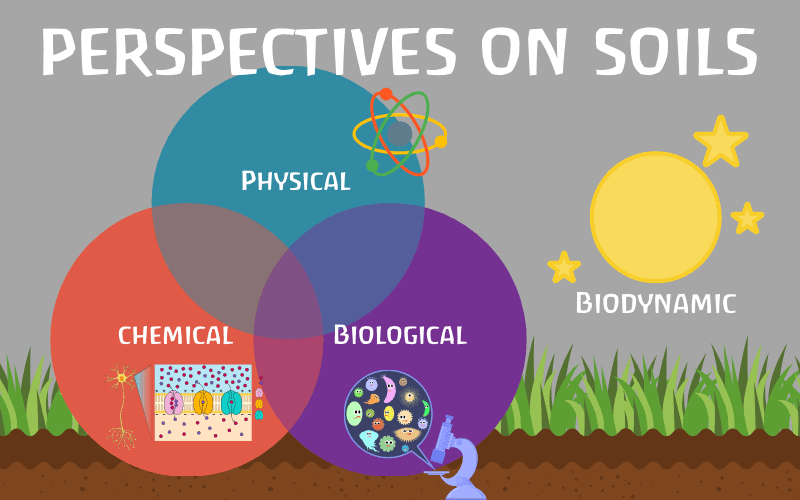
A chemical dominated view prioritised short-term crop success, over long-term healthy soils. In this essay, I will investigate soil from a Physical, Chemical, Biological, and Biodynamic perspective, seeking a holistic understanding of soil.
I will also outline various ways of assessing the health of soils and conduct a soil test, prior to suggesting practices and cultivation styles to improve or maintain soil health, such as the no-dig or introducing biochar.
The Functions Of Soil
- Providing physical support for the plant – Physical
- Holding water, air, and nutrients, all of which are essential to plant growth – Chemical
- Providing habitat for microorganisms, bacteria’s, and fungi, all of which are essential to healthy plant growth – Biology
Physical Perspective On Soil
A physical perspective of soil is often the easiest to observe. By looking at the soil surface we can begin to gain insights into the health of the soil.
How Is The Soil Formed?
(1.2) Soils have been formed over millions of years. It takes 200-400 years to form 1 cm of soil in mild climates such as England, and in wet tropical areas, soil formation is faster, as it takes 200 years. Crucially, for soil to accumulate enough substances to make the soil fertile it takes 3000 years.
The formation of soils begins with the weathering of rocks that produce mineral particles. This can happen Physically, Chemically, and Biologically. The soil formation is influenced by the following five factors.
Biologically lichens and other primitive life forms like mosses colonize bare rock and then secrete acids to eat at the rock, laying the groundwork for the base of the soil. When the lichens lifecycle comes to an end, they die and combine with the minerals that had unlocked from the stone through digestion. You have to extrapolate this process across millennia to visualize the mineral and organic matter growing deeper, and allowing more complex organisms to thrive on the soil foundations.
Roots of plants can also penetrate into crevices, while continuing to grow, and dislodge minerals. The dead plant roots will also become part of the soil, and while the structure is composed it can potentially be a channel to allow water into the rock, further weathering it from the inside.

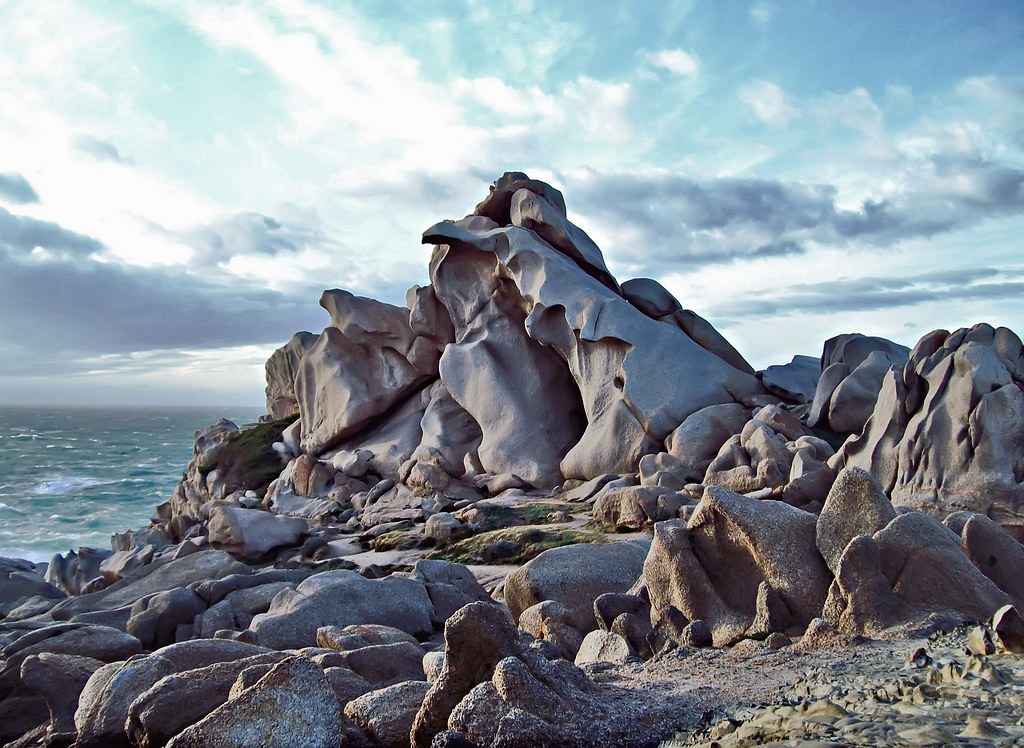
Physical weathering occurs through fluctuations in temperature, heat causes the structure of the rock to expand, and cooler temperatures cause the rock to contract. Over time, this results in a weaker structure susceptible to fracturing.
Wind also has the ability to aid the formation of soils by weathering rocks, grains of sand can be picked up by the grasp of the wind, and slowly wear the rock down. Wonderful examples of weathered rocks can be found in Sardinia, such as Valle Della Luna in the north of Sardinia, the coastline is susceptible to strong eastern mistral winds, which have created unique rock formations.
From a chemical perspective, water will dissolve minerals from the rocks, through rainfall or through the water in the soil which is normally slightly acidic. Water can even creep into rock crevices, freeze, and split rocks. On a more dramatically note weathering can occur rapidly through volcanic eruptions, earthquakes, and glaciers.
The Components Of Soil
(1.3) The physical, biological, and chemical weathering has unlocked and created an environment for the soil components to come together, including minerals, water, air, organic material, and living organisms. All soils will have varying proportions of these components, for example, peat soil is formed in waterlogged conditions where organic matter is unable to break down.
Soil Horizons
During the soil course at Ruskin Mill, we visited the small quarry in the hazel coppice woodlands where we could identify the organic surface litter, topsoil, clay-heavy subsoil, and limestone bedrock.
Humus Layer, Topsoil & Subsoil

- The topsoil is the uppermost horizon, it is likely to be the most fertile part of the soil, contain the most microorganisms, a good depth would be between 25-60cms. As it is the top layer, it will also collect all of the organic matter such as the leaf litter from the autumn, this gives the soil its dark colour.
- The subsoil is made up of large aggregates than the topsoil, it won’t contain as many microorganisms organic matter, because of the lack of air. The colour is all much lighter, which is why the subsoil is clearly differentiated from the topsoil.
Sand, Silt, and Clay
(1.1) Soils are made up of sand, silt, and clay of varying amounts depending on the location, each type has different characteristics. A soil that is a balanced mix of each type is the most desirable as it carries the characteristics, and advantages of each type, this is known as a loamy soil type. There are eleven major classes of mineral soils, all of which are the proportion of sand, silt, and clay (this can be seen in the colour ratio pyramid below, (Loam is in the centre as it is the most balanced of all the types)
| Type/Characteristics | Gritty | Soapy | Sticky | Forms Threads | Forms Rings |
| Sand | Yes | No | No | No | No |
| Silt | No | Yes | No | Yes | No |
| Clay | No | No | Yes | Yes | Yes |

Sand
Sand gives the soil a permeable quality and makes it easier to work with. However, it must be said that an excessive presence of sand poses fertility problems. Sand does not retain water and also has a low nutrient retention capability, both of which are essential for plant growth
Silt
Silt stands as an intermediary between the contrasting characteristics of sand and clay. Larger silts have properties similar to those of sand, the finer ones to those of clay.
Clay
Counter-intuitively clay is the finest element of the soil. It has high colloidal properties that cement themselves together, which creates a very compact layer. Too much clay will give the soil poor drainage that will affect the fertility of the soil, this is partly countered by the clays ability to retain nutrients.
Comparing Soil Textures
During the soil course, we covered two simple experiments to gauge the physical constituents of the soil. We can identify the ratios of Sand, Silt, and Clay because of the varying properties.
In the book Bio-Dynamic Gardening by John Soper (1983) the sizes of particles are given for Sand, Silt, and Clay. I have presented his findings below.
| Diameter | Amount Of Particles Required To Cover A Square Inch | |
| Coarse Sand | 2-0.2 mm | 250 |
| Fine Sand | 0.2-0.02 mm | 2,500 |
| Silt | 0.02-0.002 mm | 25,500 |
| Clay | >0.002 mm | <50,000 |

To gain a quick understanding of the constitution of your soil you can take a sample of moist soil about the size of a golf ball, knead it, and then press it into a ball. If it feels gritty that it will be high in sand, if it can be moulded then clay and silt are the main elements
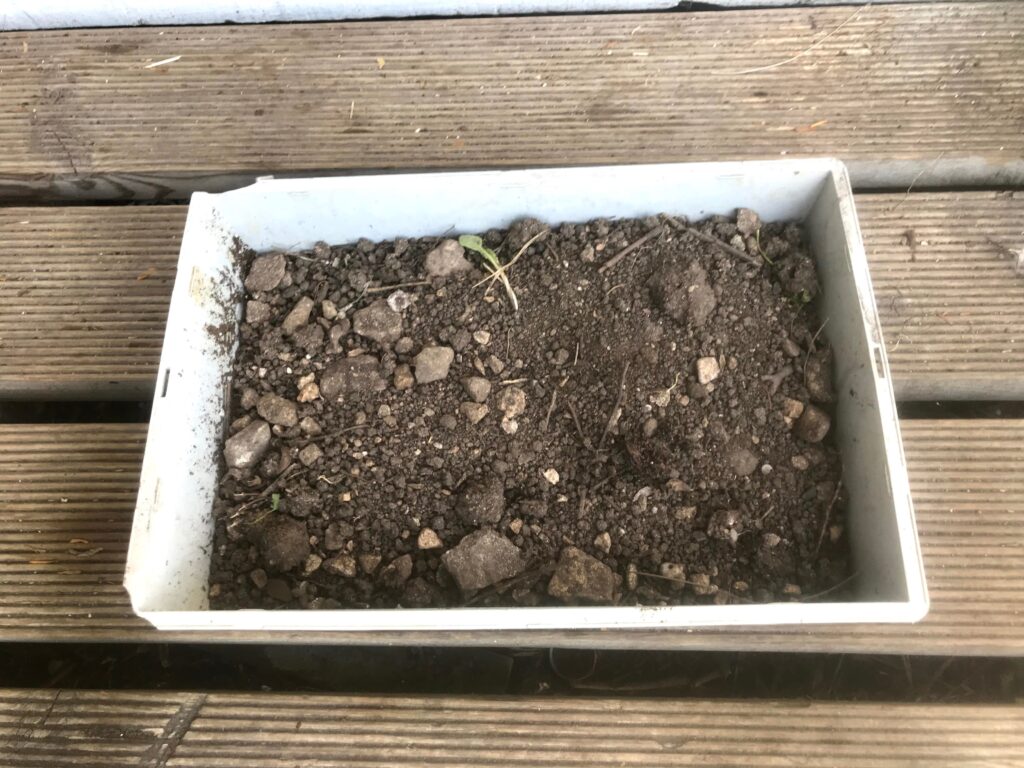





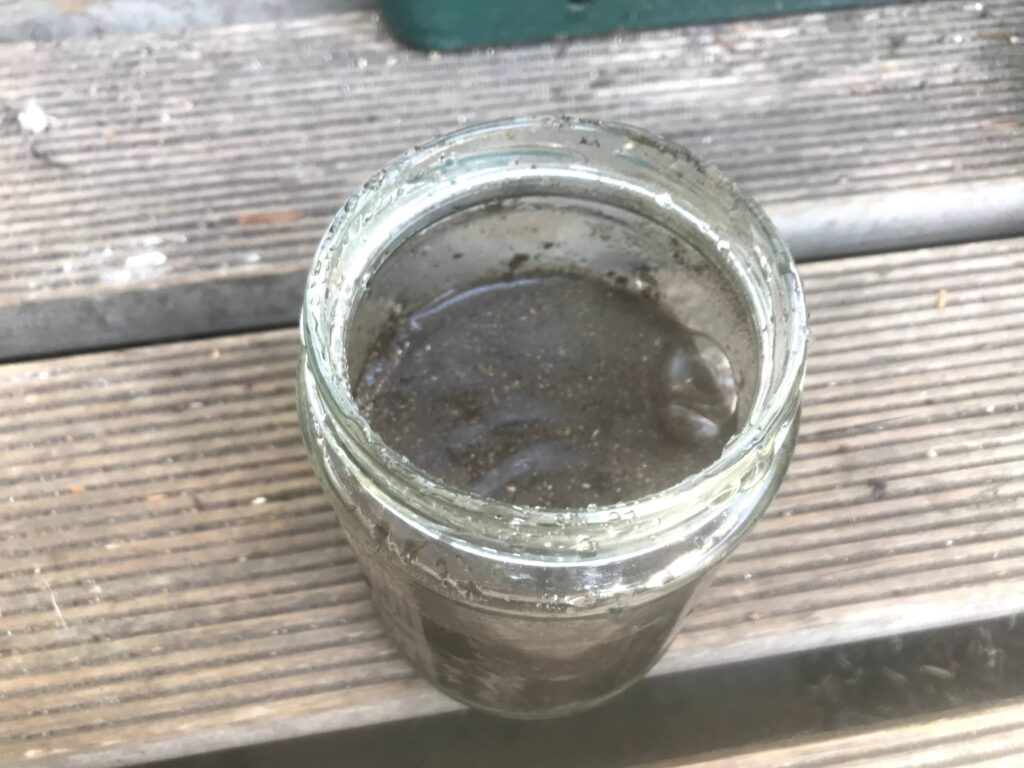

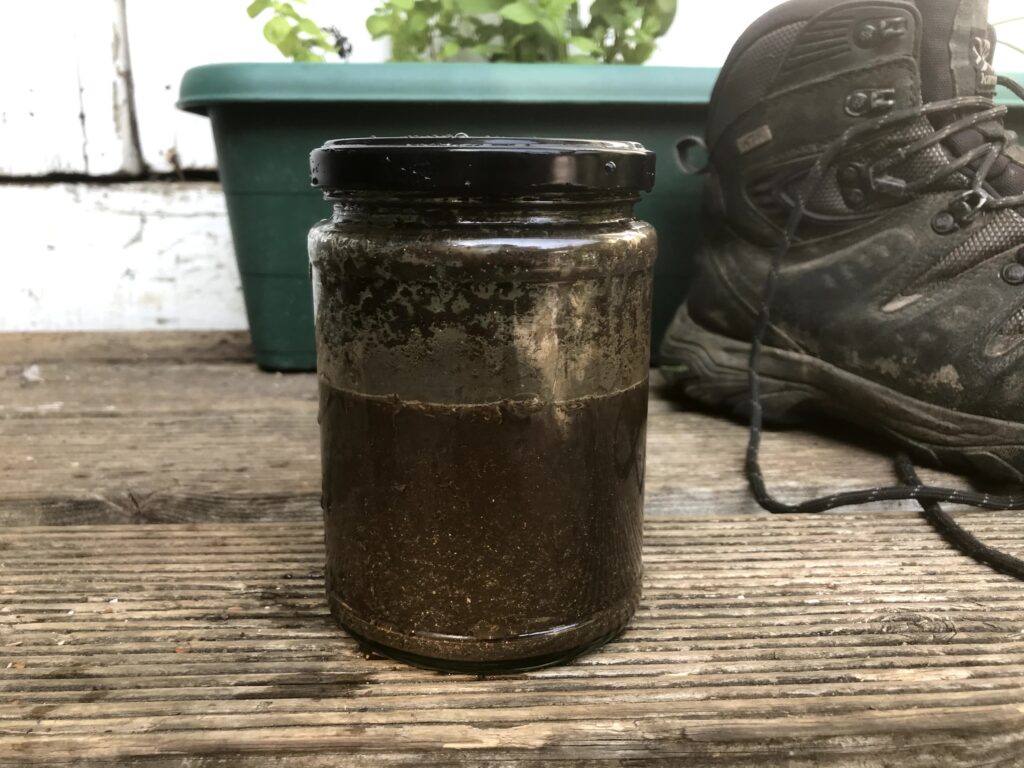
Soil is made up of Clay, Silt, Sand, and Organic matter. These unique combinations determine its colour, texture, and its holding capacity for nutritious chemicals.
Chemical Perspective On Soil
A chemical perspective of soils is essential to growing plants, often it overshadows the physical and biological aspects of soil health, which has led to a reliance on chemical fertilizers, and a singular focus on NPK (nitrogen, phosphorus, and potassium.) An underappreciation of the other elements important to growing food has given us less nutrient-dense food for superficial foods. This could be giving us major nutrient deficiencies, because if it’s not in the soil, how can it get into the plant, and if it’s not in the plant, it won’t get into our bodies.
There are 16 essential nutrients, and these are grouped into macronutrients, secondary nutrients, and trace nutrients.
| Macronutrients (needed in large amounts) | Secondary Nutrients (moderate amounts) | Trace Nutrients (small amounts) |
| Carbon, Hydrogen, Nitrogen, Oxygen, Phosphorus, and Potassium | Calcium, Magnesium, and Sulfur | Boron, Chlorine, Copper, Iron, Manganese, Molybdenum, and Zinc |
Potential Of Hydrogen (pH)
The pH of the soil can impact what plants can be grown in the garden. Most plants will grow best at a pH of 6-7, meaning they prefer a slightly more acidic environment.
I found a soil testing kit, so I decided to do a pH test, from one of the market garden beds in the valley at Ruskin Mill. The kit included a test tube, barium sulphate, and a pH test solution.
- Fill one of the test tubes with dry soil up to 1ml
- Add 1g of barium sulphate
- Then add the pH solution until it reaches the 2.5mll mark


From the shade of green indicated by the solution, I would place the soil at a pH level of 6.8, so it is ever so slightly acidic. This pH zone is ideal for growing plants.
Cation Exchange
Chemicals from plants such as Calcium, Magnesium, Potassium, and Ammonium are all positive, and the particles in the soil are negative. This means that they will bind to each other which stops the chemicals from leaching out from the soil.
Plant roots have to exchange their cations for cations of equal value held in the soil. Cations with a positive change of +1 are realised more easily than chemicals such as magnesium (+2) or iron (+3)
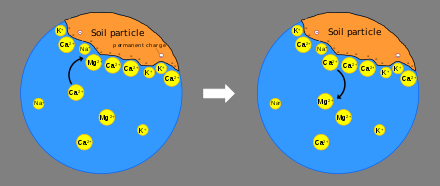
The more surface area, and amount of negatively charged cations in the soil than the higher Cation Exchange Capacity (CEC).
The cation exchange capacity is very important to determine how well plants will grow on the land. Adding organic matter to soils is one of the best ways to increase the capacity. In convention farming, this measure is very important, but short-term fertiliser chemicals are used.
Biological Perspective On Soil
On teaspoon of topsoil contains around 1 billion individual microscopic cells and around 10,000 different species. It is not a whole world below our feet but a universe. Zooming out from the microscope, we will also find insects such as Ants, which have colonies stretching continents, making them one the most successful species on the planet.
Earthworms break up the compacted soil a create pockets for air to flow and roots to grow. Fungi (the unsung hero of the soil) send out long rootlike treads through the soil, releasing chemicals to break down plant roots. While also bridging the gap between plant roots and inaccessible nutrients which lay deep in the soil or in the bedrock, in a seemingly symbiotic relationship stretching from millions of years ago.
The Soil Food Web


Decomposes organic residues from enzymes. Recycling soil nutrients.

Feed on decomposing plant material

Help mineralize nutrients, so they can be used by plants and organisms

They help recycle nutrients, but also feed on bacteria, fungi, protozoa, and even attach insects

They distribute nutrients through the soil

Establish sybotic relationships with plant roots, bringing nutrients and water to the plant in exchange for carbon
The Importance Of Fungi & Mycorrhiza

The word, mycorrhiza, comes from the Greek ‘mukès’ (fungus) and ‘rhiza’ (root).
Mycorrhiza is a symbiosis between fungi and plant roots: 92% of plant families interact with fungi in this way.
Benefits Of Worms
- Soil Structure: Earthworms leave behind worm casts which is ejected from the digestive tract of a worm, casts are very sticky, and able to hold water. They even help to build back topsoil
- Makes Nutrients Available: The worms feed on deadroots, grass, and manure, and can traform these materials to make them available to plants. The casts they leave behind are richer than the soil around them
- Drainage: Worms leave many channels throughout the soil, which allows water to penertrate deeper
- They don’t consume growing plants
- Bring Nutrients Down: Earth worms come out of night feeding on dead plant materiails on the ground level, this is later cast in their tunnels.

Biodynamic Perspective On Soil
The soil is a child of the sun. Above its surface, it is explosed to the near planets – below its surface to the distant ones. It is alive in winter, dies off in summer.
Rudolf Steiner
In Lecture II of the Agriculture Course, Rudolf Steiner indicates that aboveground activity is dependent on the ‘near-earth planets’ of Moon, Mercury, and Venus, these planets support and modify the influence of the Sun.
The ‘distant planets’ of Mar, Jupiter, and Saturn work on everything below the soil and mediates the sunlight. The Sun’s formative energy is carried into the soil via the Silica content. It is first absorbed by the ground and then radiated upwards with the support of clay in the soil.

- Silica: Helps the cosmic forces enter into the soil
- Lime/calcareous substances: Helps draw down forces from the air above the ground
- Clay: Helps the light energy rise back up
It could be said that once the sun penetrates into the soil, it can further potentialize the elections of the nutrients in the soil. Nutrients that have been blessed by the sun, and distant plants will provide a higher source of nourishment to the plants.
The preparations used in biodynamics help to increase the sensitivity of the soil to cosmic forces.
Steiner notes the underground warmth as being living, especially during winter*, the aboveground warmth as being dead. Warmth and air both become enlivened when they are absorbed into the earth.
*In our present epoch, the time between January 15th and Febuary 15th is the time when its easiest for them (earth element) to be independent of the Earth’s immediate surroundings and come under the influence of the distant cosmic forces that are within the Earth.
Rudolf Steiner
In biodynamics, midwinter is the time when the soil is most alive, which is counter-intuitive to the appearance of death that we see above the ground. It is during this time that the mineral substances in the earth crystallize, and radiates forces that are key to plant growth.
Rudolf Steiner said that the soil acts as a diaphragm for the earth, just as he understood water to be the blood of the earth.
With the farmer placed at the centre of his farm, he must take good care of the soil, ensuring that it can breathe, can retain water, and is packed with minerals and biological life to keep it fertile.
From my time working in the market garden I have understood that the act of composting and collecting animal manures is at the very heart of biodynamics, and key to the health of the soil. Steiner understood that soil was alive, full of microorganisms and life. It is our job to nurture the soil as a living being and encourage it to teem with life. From this state, the cosmic forces have more elements to enliven further to give plants everything they need to grow well.
The overwhelming majority of farms in the United Kingdom are highly specialised, so they don’t have what they need in-house to renew their soils with black gold (cow manure) or a large amount of food waste. They turn to external inputs that rack up an increasingly heavy cost over time, by depleting our soils, our health, and our environment as farming chemicals enter our streams and rivers.
Assessing The Soil
Visual Evaluation Of Soil Structure (VESS)
(2.1)During the soil course, we conducted a Visual Evaluation Of Soil Structure, all you need is a spade and the handy guide below. The test will grade the quality of the structure of your soil. Depending on the size of your land, you should test multiple areas to eliminate any outliers.
It is also important to test the structure at different times in the year, especially to see how the roots are interacting with the soil during the peak of the growing season.
As part of the three-day course, we tested the soil in three locations, purposely looked for suspect areas to see how the test worked. This included a patch of ground that had been driven over by builders vehicles, the soil structure was Sq5.
I didn’t take any photographs of these tests, so I conducted another test which you can see below. As it was one of the hottest days of the year, I selected an area of soil that was in the shade and would have some moisture.
While following the test, you could also count the number of earthworms
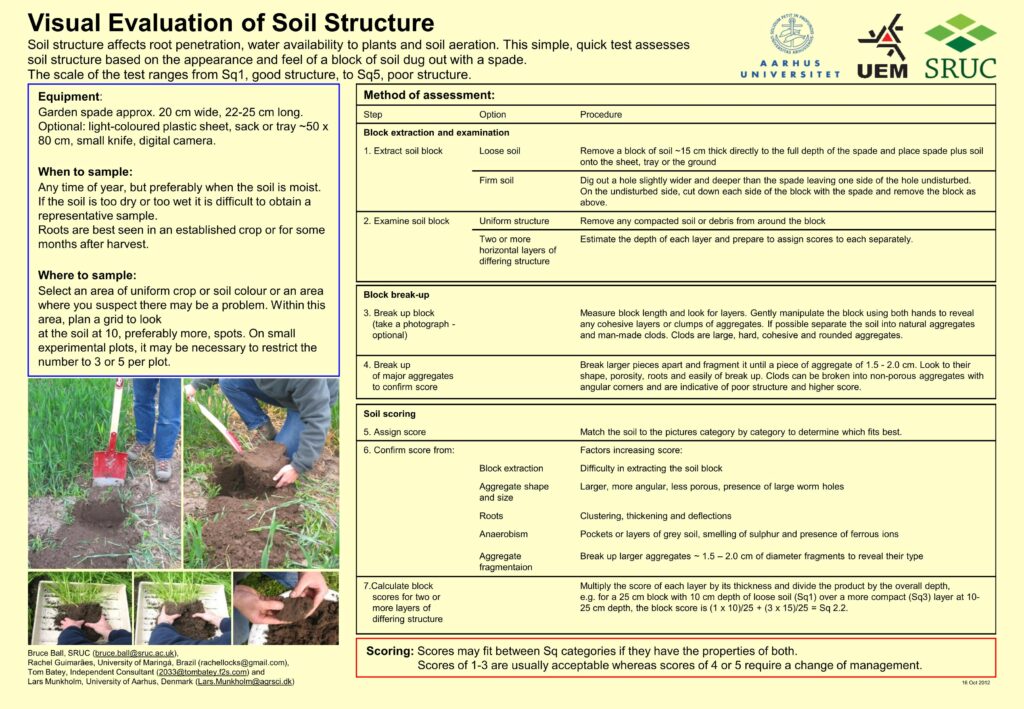
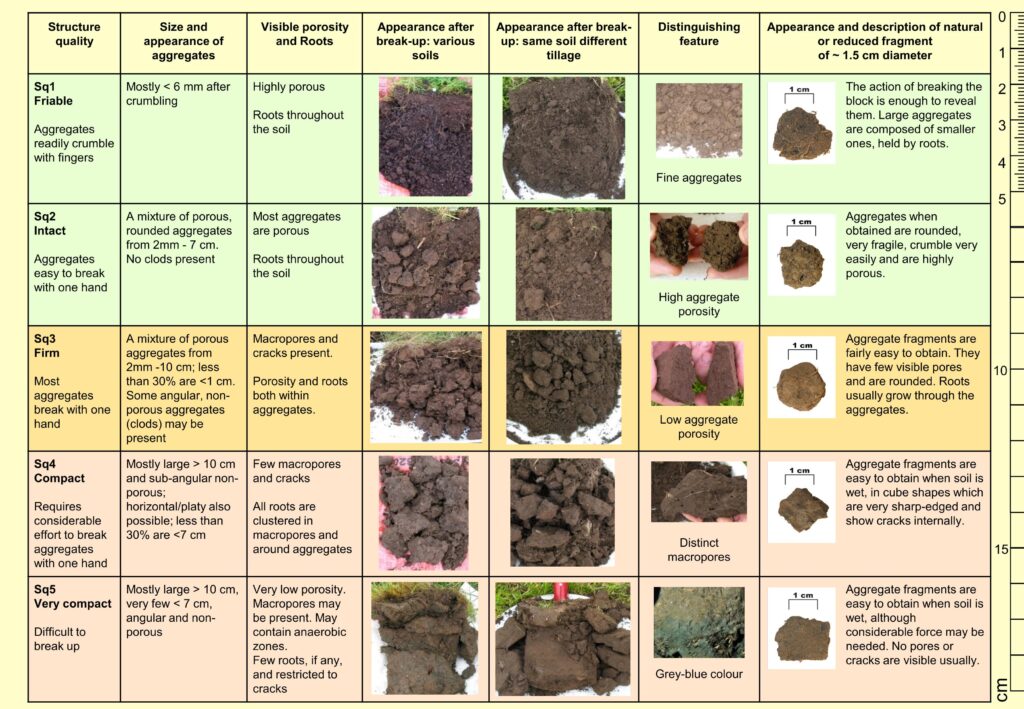
Conducting A VESS Test
When digging it is recommended to dig the two sides first, then dig the front side, and turn the turf over. This will help the sample keep its initial shape. I concluded the structure of the soil to be classed as Sq2 intact, because of the aggregates that didn’t crumble, although it wasn’t as firm or compact as other poorer soil structures.
This is a very good result, and no actions will need to be taken to improve the soil structure in this area.





Water Retention Test
Different types of soils have a higher or lower capacity to hold onto water. Soil high in clay retains the most amount of water. Sand, with its larger particles, retains the least amount of water, and silt retains a moderate amount of water.
David and I decided to conduct a water retention test, we decided upon three sources of soil that are being used within the garden, instead of artificially creating a clayey, sandy, and loamy soil only with the intention of confirming the hypostasis.
- Potting Soil: This is the soil that is used for sowing
- Clay Bed: The soil in horticulture is naturally high in clay, this was taken from a garden bed
- Carrot Bed: This soil sample was taken from the carrot bed out on the lay

The basic structure of this test involves adding an equal amount of water into each soil sample at the same time, and judging whether the water is held by the soil or accumulates quickly in the glass below.
We made a hole at the bottom of each paper cup and filled it with our three types of soil. Leaving 5mm of space at the top, so the water doesn’t overflow from the cup. We added 100ml of water at the same time.

The water passed through the soils at different rates. The potting soil was the least able to hold the water, the carrot bed soil held the water well despite being composted of 2cm aggregates, and the clay soil was dripping at a rate in between.
What The Weeds Are Signaling
| Compaction | Mustard | Dandelion |
| Low Fertility | Yarrow | Rag Weed |
| Fertile | Chicory | Foxtail |
| Acidic | Sorrel | Knotweed |
| Alkaline | Wild Carrot | Chickweed |
Actions To Improve The Soil
No Dig Method
The method of no-dig growing has grown in popularity in the last through years, particularly through the internet, and youtube channels such as Charles Dowding, who has 400,000 subscribers who watch his videos from his no-dig. garden.
No-dig gardening requires a constant input of organic matter to feed the soils microorganisms. A constant cycle of compost heaps are essential because there are much fewer weeds that grow, and then break down in the soil.
When starting a no-dig garden, areas with a large number of weeds are cover with cardboard, to aid the breakdown, and kill off any weeds. This is a good practice that I believe could be used as part of any growing method.
Garden Lime
Lime is high in calcium which is an important component to the heath of the soil. In a compost animal manures, grass cuttings provides nitrogen, dead leaves and straw provide carbon. However, we often need to bring calcium into the garden, to provide a balance. In our compost, we have fish bones which provides a good amount of calcium, but we also have to bring in garden lime, that we add to our compost pile and vegetable beds. The lime helps break down any acid organic matter in the soil. By adding it to our compost heaps, we have been able to reduce any foul smell, which have been indicating that we have an unbalanced compost.
Lime is alkaline, so it helps raise the level of pH. Therefore, it is good to check your levels of pH, to see if you need to increase or decrease the pH to suit the requirements of you crop. Most plants grow best between 5.5 – 6.5 pH.
It’s best to apply lime in the winter so I has time to integrate into the soil, which is helped by freezing and thawing periods. Lime can burn plants, and even cause irritation if handled without gloves.
Green Manures & Cover Crops
The image on the right below is of a poster showing the root depths for different plants. Biodiversity is very important because you want the different benefits that come with different plant roots.
To improve the soil in an area of agricultural land, you can leave it fallow for a year to restore its fertility. Or you can scatter a mixture of seeds that will penetrate the soil, creating more channels for oxygen, and invite insects.
Green manures, especially the more leguminous such as Alfa Alfa, Trefoil. and Broad Bean are able to improve the levels of nitrogen in the soil. They can take nitrogen from the air and bring it to their root nodules.
The green manures provide a carpet which can help suppress weeds, by keeping the soil covered the cover crop is also keeping the top layer of soil protected, and help prevent any leaching which could happen when there’s heavy rainfall.
Green manures can be sown for the short-term (2-3 months) or for the long-term (6 months up to 5 years). Short-term cover crops are often used a one to three months before the main crop will go in. Longer term cover crops are used to restore biomass, and fertility to a bed that has recently had a crop taken out.


Composting & Manures
(3.2 & 3.3) The composting of organic matter is a fundamental part of biodynamics, it is an effective way to return the goodness and fertility back into the soil that was lost during the growing season. It helps maintain the cycle of fertility by recycling nutrients, so you can minimise the amount of excess material that you bring into your holding.
The plants, weeds, and kitchen scraps that have gone into the compost have spent much of their time gathering minerals from you soils, they have become rich in nitrogen, composting breaks down these organic plant, putting the vitality back into the soil. This is key in biodynamics as a farm should aim to be as self-sufficient as possible.





Composting provides your soil with all the nutrients, micronutrients, and organisms it needs while suppressing harmful ones. The kills diseases, pests, and the seeds of weeds so they won’t find their way back into your garden beds.
How To Build A Biodynamic Compost Pile?
Synergistic Gardening
Synergistic gardening is very popular within permaculture. It was developed in the 1980s by Emilia Hazelip. A couple of years ago I visited a friend synergistic garden in Sardinia, they had countless types of vegetables all growing on top of each other, with no clear structure. It was as if they mixed up all of their vegetable seeds and scattered them at random.
There were weeds, but they were greatly suppressed by the spectrum of vegetables all fighting from light, and nutrients.
They never dug the soil, not even superficially. Thus protecting the soil structure, bacteria, and all of the fungi.
The abundant array of vegetables growing would become the fertilizer for the soil, as there was so much growing, and it was so mixed that it was impossible to harvest everything. The only thing they did was to continually lay down humus during the winter, and Autumn.
Biodynamic Preparations
There is a polarity between limestone and silica, these substances help capture growth forces from the inner and outer planets and make them available to plants. Through the lime process, the forces of the inner planets go into the earth and then radiate upwards, while the forces from the outer planets radiate down and are captured by the silica process.
The silica forces from the outer planets can be said to be one of light and warmth, and so they affect the plant in a similar way by helping the ripening, and nourishment. By spraying preparations 501 & 508 we are helping enhance the ability of the forces from the outer planets to be harnessed.
The cow horn manure preparation 500 helps bring calcium forces to the earth, which helps the soil’s ability to capture the watery/reproductive forces from the inner planets.
(2.2 & 3.4) There are nine core biodynamic preparations, they are used to improve soil health. Each preparation is used for different reasons, depending on the qualities inherent within them. For example, the stinging nettle compost preparation 504, relates to nitrogen and iron and stimulates the breakdown of organic materials in the compost.


| Biodynamic Preparation | Source | Quality | Application | |||
| 500 Cow Horn Manure | Fresh cow manure, and cow horns | Enhances the life of the soil | Spray | |||
| 501 Cow Horn Silica | Clear quartz (Silicon dioxide) triturated into a fine powder | Increases plant immunity and enhance ripening | Spray | |||
| 502 Yarrow | Flowers of Yarrow (Achilea millefolium) | Helps the soil drawn in substances | Added to Compost | |||
| 503 Camomile | Flowers of Camomile (Matricaria chamomila) | Helps to stabilise plant nutrients and invigorate plant growth | Added to Compost | |||
| 504 Stinging Nettle | Whole Stinging Nettle (Urtica dioica) | Develops sensitivity in the soil, and helps to stabilise nitrogen | Added to Compost | |||
| 505 Oak Bark | Oak Bark (Quercus robur) | Helps increase a plants resistance to disease | Added to Compost | |||
| 506 Dandelion | Flowers of Dandelion (Taraxacum offcinale) | Activities light influences in the soul | Added to Compost | |||
| 507 Valerian | Flowers of Valerian (Valeriana officinalis) | Protection | Sprayed over Compost | |||
| 508 Horsetail | Flowers of Horsetail (Equisetum arvense) | Prevents fungal diseases, and balances the water elements | Spray |
The Case For BioChar




Primary & Secondary Soil Cultivations
(4.1 & 4.2) Primary soil cultivation goes deeper into the soil than secondary cultivation. This January in the valley, I used a spade to give primary cultivation of the market garden beds. This included removing the crops from the previous season and going down a spades depth to aerate and improve the soil structure. After the 15th of February, (when the soil ends its month-long rest period) I will use secondary cultivation methods to shape the beds and remove any weeds that have grown on the top couple inches of soil. I will avoid cultivating any deeper as I want to keep the soil structure that has formed over the last couple of months.
There is a lot of interest currently around the no-dig method. This limits primary cultivation to the initial stages. By not disturbing the soil, the structure is improved and fungal and insect life isn’t disturbed.
Contrary to the no-dig method, in ancient times, the greeks discovered that landslides were the most fertile place to grow plants. I understand that primary cultivations and raised beds are a way to artificially recreate landslides.
I think that there is a big difference between primary cultivation done with a spade, or primary cultivation done with a mechanical rotator. A garden bed carefully double dug with a spade each winter may create the best soil structure, if the gardener is careful. For example, you don’t want to mix the different soil layers when digging or dig when the soil is wet.
Bed preparation must be done well to provide the proper soil structure, that allows for uninterrupted and healthy plant growth. We cannot rush to make garden beds in early spring, we need to start the process in January. It is no good transplanting our vegetables into mud, watch them fail. To give our plants the best chance we need the soil to be aerated, high in organic material, and to have a good structure.
Recent Posts
Ideal Dates for Applying the Biodynamic Preparations in the Year
9th May (afternoon) - Stirring and Spraying 500 12th May (morning) - Stirring and Spraying 501 21st May (morning) - Stirring and Spraying 5015th or 6th June (afternoon) -...
What Does the Soundscape of Green Woodwork Afford for Self-regulation?
This essay is written as part of an MA in PSTE at Ruskin Mill Centre For Practice & Huddersfield University“There is music in the work and shavings dance from a well-honed...
